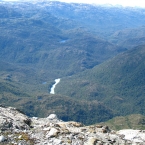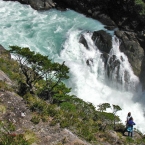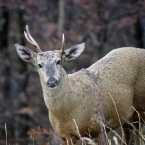Exploring the Pascua - Part I
Before it reaches a fjord that links it with the Pacific Ocean, the Pascua River, in Chilean Patagonia, races for forty miles between the two largest ice-fields on Earth outside Antarctica and Greenland, cutting its path between two jagged mountain ranges. Born in South America's deepest lake, the Pascua is one of the fastest rivers in the world, embedded in a maze of canyons draining snow-capped peaks and glaciers.
It’s also one of the most secluded. Today there is only one road that will take you anywhere near the Pascua. Known unofficially as ‘Pinochet’s Road’ for the former Chilean dictator who pushed for its construction, the road is officially named after the military work camp at its end: O'Higgins.
Despite the obstacles, an expedition organized by International Rivers was determined to start at the beginning of the Pascua and explore as much of it as we could in a week. Also, though most river expeditions spend a good bit of time on the river in a boat, we concluded that the Pascua was too wild for that. It had been kayaked only once—and that very experienced crew was able to kayak only part of the river. They recommended against any kind of boating on the Pascua for our inexperienced group of eight.
So we decided on backpacking. And after examining topographic maps of the area, it became clear that would require some pretty major physical exertion. You either have to climb through the bewildering and seemingly endless series of canyons that forms the river’s drainage, or you have to climb up to where each canyon begins and descend back down as close to the river as you can—then repeat this exhausting climb and descent for every canyon.
Our expedition to the Pascua, January 22 through 29, 2008, included me and seven other people. The others were expedition leader, Gary Hughes; local guide, Rene Millacura; Chilean documentary maker, Italo Retamal; Aysen resident, journalist and leader of the group Defenders of Patagonia's Spirit, Carlos Garrido; German ecology students, Anna Rudlof and Maren Kloske; and British journalist, Colin Barraclough.
The day before our expedition began at the source (“el nacimiento”) of the Pascua, we went with Villa O'Higgins residents and members of the Patagonian Defense Council to visit a place near the river’s first waterfalls. According to our guide, less than 100 people had previously seen these falls on foot. Unfortunately, if plans to build three massive hydroelectric dams on the Pascua move forward, these first falls would remain little known forever. The huge Matte Group conglomerate in Chile is promoting these dams through a joint venture with Europe's Endesa called “HidroAysen” and controlled by the Italian monopoly Enel. These exquisitely beautiful first falls on the Pascua would be totally destroyed by the very first dam.
Our expedition was determined to know first-hand what else the Matte Group, Endesa and Enel would destroy with their dams. Although Chilean legislation requires a type of “environmental impact assessment,” very few Chileans—outside the powerful interests promoting the dams—speak favorably of this process. Considering the Pascua’s remoteness and ruggedness, the environmental impact assessment has been so far accomplished only through highly paid consultants ferried to brief encounters with the Pascua by helicopter for sampling. We do not believe that this will yield meaningful knowledge of how the river and its associated web of life would be affected by the dams.
And based on our topographic information, we did not expect to find many places flat and open enough for helicopter landings. We expected the kinds of forbidding terrain that are the last refuge of shy and critically endangered animals such as the huemul, a kind of deer that the dams would bring closer to extinction. That’s why we needed the participation of Rene Millacura, a park ranger for Valle Chacabuco Reserve who has considerable experience in what wilderness trekkers call ‘the back country’.
We also needed to drink lots of Pascua water because walking steadily through rugged terrain with a loaded backpack creates a powerful thirst. On three of our days, we spent more than 10 hours walking—up and down the sides of hills, around and over ravines, through dense brush, moss and mud—and a type of very strange, marshy territory called ‘mallin’—and finally to the tops of three unnamed peaks, each of which is higher than 1000 meters.
The Pascua made sure we had plenty of the planet’s purest water to drink. On that first night, after the motorized raft left, my first task was helping to bring the group water for the night and next day. Drinking that first mouthful of Pascua water broke a taboo that many of the world’s citizens must have against unboiled water from rivers. How liberating—and delicious—it was to break that taboo!
We had to cross two rivers, but neither was the Pascua, for us an impossible river to cross. Our route took us to the confluence of the rivers Quiroz and San Pablo with the Pascua. To reach the Quiroz, we crossed the San Pablo with no problem and walked to a cable crossing installed years ago by one of the predecessor companies to HidroAysen. Our plan was to get across the Quiroz on the cable. Our problem was that the car for crossing the cable had been left on the other side of the river.
Solving that problem led to our expedition’s most dramatic event. We took a day off from walking partly to reach agreement on a solution. Meanwhile, we decided to do a little exploring. We found two huemul skeletons—probably the remains of kills by the Chilean cougar known as the puma—and saw both the ashy-headed goose (chloephaga poliocephala) and torrent duck (merganetta armata). Near two survey markers, we also found some electrical wire and a large, recently dug square hole—some of the few signs we saw of previous human activity during our expedition. A short distance from the square hole we also noticed very recent marks from the landing skids of a helicopter, surrounded by shoeprints.
But back to that problem of the cable and its ‘car’, which is really just an open metal basket that can hold no more than one person at one time: As we approached the cable, without letting the group know he was going to do this, Rene, our local guide from Valle Chacabuco Reserve, began to climb across the cable, upside-down and bare handed. For the first few minutes Rene was on the cable, we thought he might turn back after realizing how difficult it would be. But, as the Quiroz roared under him—at one point, the cable sagged and the river literally began hitting him in the back—Rene just kept going. I knew halfway through his hands were bleeding from gripping the sharp wound-steel of the cable—I saw him dip his hands repeatedly in the water—but it didn’t faze him. Before Gary and I could decide on an appropriate plan to rescue Rene if he fell in the river, he reached the other side and began moving back across in the car. Afterward, we cheered his heroism—and treated his badly blistered hands.






